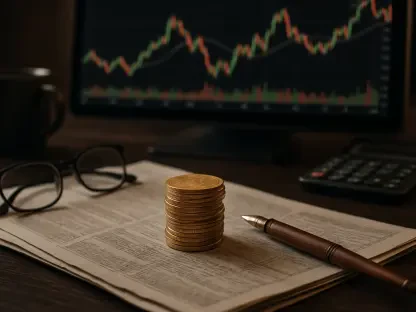In a dramatic turn of events, the U.S. stock market, as tracked by the Vanguard S&P 500 ETF (VOO), mounted an impressive recovery on Monday, August 4, following a punishing sell-off the previous Friday. After suffering a steep 1.6% decline driven by disheartening economic data, including a lackluster July jobs report and downward revisions to prior figures, investors returned to the trading floor with a renewed sense of purpose. By the close of the day, the S&P 500 had surged by 1.5%, nearly erasing the losses from the week’s earlier turmoil. This swift rebound highlights a notable shift in market sentiment, as participants appear to be reevaluating the impact of negative economic signals while seeking out potential bright spots on the horizon. Such resilience in the face of adversity underscores the complex dynamics at play, where fear and optimism often collide, shaping the trajectory of one of the world’s most watched indices. This recovery sets the stage for a deeper exploration of the forces driving the market’s behavior.
Weathering Economic Storms with Market Grit
The sharp decline witnessed on Friday was largely a reaction to troubling economic indicators that painted a grim picture of the current landscape. A weak July jobs report, coupled with downward adjustments to previous months’ data, stoked fears of an economic slowdown, sending ripples of concern through the investment community. However, Monday’s performance told a different story, with the VOO ETF starting the day with a modest 0.6% gain in premarket trading and building momentum to close at a robust 1.5% increase. This turnaround suggests that market participants are not entirely swayed by the gloomy data but are instead focusing on potential stabilizing factors. Speculation about the Federal Reserve stepping in with interest rate cuts to counteract economic softening has likely contributed to this renewed confidence, offering a glimmer of hope that policy measures could help steer the economy back on course.
Beyond the immediate reaction to economic news, the market’s ability to rebound so quickly points to a deeper resilience ingrained in its structure. While Friday’s sell-off reflected genuine concerns about growth prospects, Monday’s rally indicates that investors are willing to look past short-term setbacks and consider longer-term opportunities. The steady climb of the VOO ETF throughout the day demonstrates a collective mindset shift, where the initial panic subsided, giving way to a more measured assessment of risks and rewards. This behavior also reflects an understanding that economic data, while critical, is just one piece of a larger puzzle. Factors such as corporate performance and policy expectations play equally significant roles in shaping market direction, suggesting that the S&P 500’s recovery is not merely a fluke but a calculated response to a multifaceted environment.
Corporate Strength as a Market Anchor
Amidst the economic uncertainty, a wave of encouraging earnings reports from S&P 500 companies provided a sturdy foundation for Monday’s market upswing. Companies like onsemi, Tyson Foods, and Waters Corporation delivered results that either met or surpassed analyst expectations, injecting a dose of optimism into a market hungry for positive news. These strong performances underscored the robustness of corporate America, serving as a counterbalance to the broader economic concerns that had initially spooked investors. While not every reaction was uniformly positive—Waters Corporation, for instance, experienced a minor dip in premarket trading despite a solid earnings beat—the overall impact of these reports was to bolster confidence, pushing the VOO ETF higher as the day progressed and reinforcing the notion that individual company health can drive index-wide gains.
The significance of these earnings extends beyond mere numbers, as they reflect a broader narrative of adaptability and resilience among major corporations. Even in a climate of economic headwinds, many S&P 500 constituents have managed to navigate challenges effectively, whether through cost management, innovation, or strategic positioning. This corporate vigor offers a reassuring signal to investors who might otherwise be deterred by macroeconomic gloom. The positive earnings momentum also highlights the diversity within the index, where sectors ranging from technology to consumer goods contribute to overall stability. As such, the market’s reliance on these corporate pillars during turbulent times becomes evident, suggesting that the strength of individual firms can act as a buffer against wider economic volatility, providing a critical lifeline for the S&P 500’s recovery on this particular day.
Spotlight on Individual Stock Surges
Adding color to the broader market recovery, several individual stocks within the S&P 500 posted remarkable gains that captured investor attention on Monday. ViaSat, for instance, skyrocketed by an impressive 23%, fueled by an analyst upgrade and whispers of a potential spinoff or IPO of its defense division, showcasing how company-specific developments can have outsized effects on stock performance. Similarly, Wayfair saw its shares climb over 9% after reporting earnings that were nearly triple the forecasts, reflecting strong consumer sector performance. These standout moves not only contributed to the upward momentum of the index but also highlighted the importance of granular, firm-level news in shaping overall market trends, even amidst overarching economic concerns that might otherwise dominate the narrative.
Another intriguing case was BioNTech SE, which managed a 4.1% stock increase despite posting a quarterly loss worse than anticipated. The gain was driven by revenue figures that exceeded expectations, illustrating the nuanced way investors weigh different financial metrics depending on context. Such varied responses to earnings reports reveal the complexity of market dynamics, where a single piece of negative news does not necessarily spell doom if other indicators provide a silver lining. These individual stock performances collectively paint a picture of a market that, while influenced by macro trends, remains deeply responsive to micro-level developments. The ability of specific companies to rally investor enthusiasm through strategic announcements or unexpected financial outcomes underscores the layered nature of the S&P 500’s rebound, where every stock tells a unique story within the larger recovery framework.
Navigating Macro and Political Crosswinds
While corporate earnings provided a lift, the shadow of macroeconomic and political factors continued to loom over the market, influencing investor sentiment in subtle yet significant ways. The disappointing jobs data and the impact of tariffs under President Trump’s policies were cited as primary catalysts for Friday’s sell-off, creating a backdrop of uncertainty that carried into the new week. However, by Monday, a sense of cautious hope emerged, largely tied to speculation about the Federal Reserve’s potential response to economic softening. The possibility of interest rate cuts, which could lower borrowing costs and stimulate investment, offered a counterpoint to the earlier pessimism, suggesting that policy tools might help mitigate some of the economic challenges weighing on the market.
Additionally, the interplay between political decisions and economic policy added another layer of complexity to the market’s outlook. Tensions between political figures and the Federal Reserve have historically created friction, but the prospect of rate reductions could serve as a bridge to ease such conflicts, fostering a more stable environment for financial markets. Investors appear to be factoring in these possibilities, balancing the immediate impact of tariffs and weak employment figures against the potential for supportive monetary policy. This delicate dance between macroeconomic realities and political maneuvers shapes the broader context in which the S&P 500 operates, reminding market participants that external forces beyond corporate control can sway sentiment. Monday’s recovery, therefore, reflects not just a response to earnings but also a calculated bet on future policy directions that could bolster economic and market stability.
Balancing Optimism with Underlying Risks
Monday’s market performance encapsulated a mood of cautious optimism that permeated the investment landscape. Despite full awareness of the risks posed by a potential economic slowdown and ongoing policy uncertainties, the 1.5% gain in the VOO ETF signaled a collective willingness to focus on positive developments, such as corporate earnings strength and the potential for Federal Reserve intervention. This balanced perspective suggests that while challenges remain, there is a belief in the market’s capacity to weather storms through a combination of internal resilience and external support. The day’s trajectory reflects a nuanced understanding among investors that short-term setbacks do not necessarily derail long-term growth prospects, provided there are mechanisms in place to address underlying issues.
Looking back, the swift rebound on August 4 demonstrated the market’s ability to pivot from despair to determination in a matter of days. As attention turns to the future, stakeholders are encouraged to monitor upcoming economic data releases and Federal Reserve announcements closely, as these will likely provide critical clues about the sustainability of this recovery. Keeping an eye on corporate earnings will also remain essential, given their proven role in anchoring market confidence. The path forward may involve navigating additional volatility, but the events of this day offer a blueprint for resilience—balancing immediate corporate successes with strategic anticipation of policy shifts. This approach could serve as a guide for maintaining stability in uncertain times, ensuring that the S&P 500 remains a barometer of both challenge and opportunity in the evolving financial landscape.









